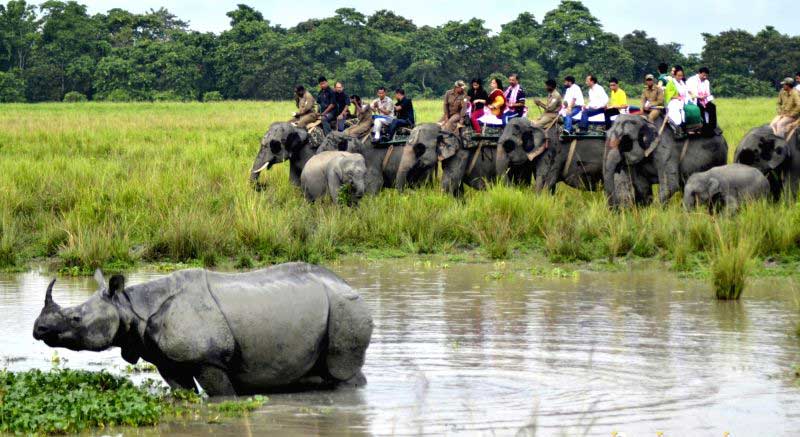Kaziranga National Park is situated in the north-eastern region of India and famous across the world for one horned rhinos and elephants who dwell there. Covering 42,996 ha, and located in the State of Assam it is the single largest undisturbed and representative area in the Brahmaputra Valley floodplain. The Kaziranga National Park is home to significant populations of various threatened species of fauna including tigers, elephants, wild water buffalos and bears as well as several aquatic species such as the fresh water Ganges River dolphins and migratory birds who visit the place in the cold seasons.
The place is scene depicting a big expanse of tall elephant grass, marshlands and dense tropical moist broad leaf forests, criss-crossed by four major rivers, including the Brahmaputra, and the park includes numerous small bodies of water. Kaziranga has been the theme of several books, songs, and documentaries.
Kaziranga contains significant breeding populations of around 35 mammalian species, of which 15 are threatened as per the IUCN Red List. The wildlife park has the distinction of being home to the world’s largest population of the Greater One-Horned Rhinoceros, wild Asiatic water buffalos and eastern swamp deers. Significant populations of large herbivores include the elephants, gaur and sambar. Small herbivores include the Indian muntjac, wild boar, and hog deer. Kaziranga has the largest population of the Wild water buffalo anywhere accounting for about 57% of the world population. The One-Horned rhinoceros, Royal Bengal Tiger, Asian elephant, wild water buffalo and swamp deer are collectively known as ‘Big Five’ of Kaziranga.
Kaziranga is one of the few wild breeding areas outside Africa for multiple species of large cats, such as Bengal tigers and leopards. Kaziranga was declared a Tiger Reserve in 2006 and has the highest density of tigers in the world, with a population of 118, according to the latest census. Other feline species include the elusive jungle cat, fishing cat, and the leopards. Small mammals include the rare hispid hare, Indian gray mongoose, small Indian mongooses, large Indian civet, small Indian civets, Bengal fox, golden jackal, sloth bear, Chinese pangolin, Indian pangolins, hog badger, Chinese ferret badgers, and parti-coloured flying squirrels. Prominent among the monkey species are the Assamese macaque, capped and golden langur, as well as the only ape found in India, the hoolock gibbon. Otter can be widely seen in the Kaziranga National Park too.
Kaziranga is also home to a variety of migratory birds, water birds, predators, scavengers, and game birds. Birds such as the lesser white-fronted goose, ferruginous duck, Baer’s pochard duck and lesser adjutant, greater adjutant, black-necked stork, and Asian openbill stork migrate from Central Asia to the park during winter. Riverine birds include the Blyth’s kingfisher, white-bellied heron, Dalmatian pelican, spot-billed pelican, Nordmann’s greenshank, and black-bellied tern. Birds of prey seen in this wildlife park include the rare eastern imperial, greater spotted, white-tailed, Pallas’s fish eagle, grey-headed fish eagle, and the lesser kestrel.
Kaziranga was once home to seven species of vultures, but the vulture population reached near extinction, supposedly by feeding on animal carcasses containing the drug Diclofenac. Only the Indian vulture, slender-billed vulture, and Indian white-rumped vulture have survived. Game birds include the swamp francolin, Bengal florican, and pale-capped pigeon.
Other families of birds inhabiting Kaziranga include the great Indian horn bill and wreathed horn bill, Old World babblers such as Jerdon’s and marsh babblers, weaver birds such as the common baya weaver, threatened Finn’s weavers, thrushes such as Hodgson’s bushchat and Old World warblers such as the bristled grass bird. Other threatened species include the black-breasted parrotbill and the rufous-vented grass babbler.
Two of the largest snakes in the world, the reticulated python and rock python, as well as the longest venomous snake in the world, the king cobra, inhabit the park. Other snakes found here include the Indian cobra, monocled cobra, Russell’s viper, and the common krait. Monitor lizard species found in the park include the Bengal monitor and the Asian water monitor.[22] Other reptiles include fifteen species of turtle, such as the endemic Assam roofed turtle and one species of tortoise, the brown tortoise. 42 species of fish are found in the area, including the Tetraodon.
The Kaziranga Wildlife Park Sanctuary remain closed from 01 May till 31 Oct every year for visitors. Therefore the time period of November to April is the best time to visit Kaziranga National Park. During the summer season the climate remains dry and windy; one can find animals around the water bodies. Kaziranga National Park is a birding paradise; the grasslands are a raptor country that can be seen on safari makes a remarkable experience. Tourists visiting Kaziranga Wildlife Park can expect find refreshment centers, restaurants and wine shops in the region.
We also offer tourist car rentals from Guwahati and Shillong to visit this famous wildlife park in Assam. Feel free to get in touch with us to pre book a car and pay later.




